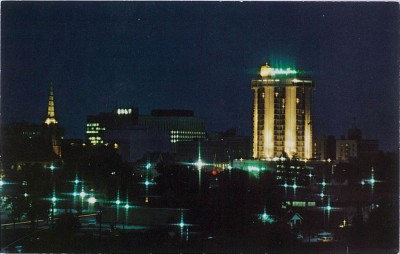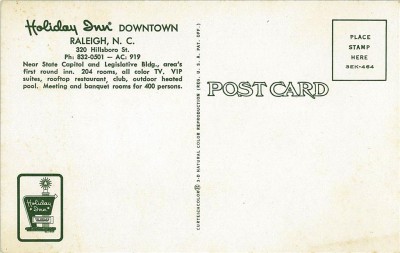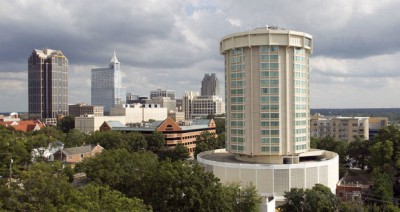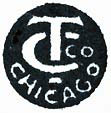Holiday Inn Downtown, Raleigh, N.C.
This week for Flashback Friday we revisit a downtown Raleigh landmark — the former Holiday Inn on Hillsboro St. — this time at night.
Holiday Inn Downtown
Raleigh, N.C. 320 Hillsboro St., Ph: 832-0501 — AC: 919
Near State Capitol and Legislative Bldg., area’s first round inn. 204 rooms, all color TV. VIP suites, rooftop restaurant, club, outdoor heated pool. Meeting and banquet rooms for 400 persons.
No message this week. Maybe a visitor to Raleigh picked up this card not to send home, but to add to his pictorial travelogue.
Two years ago Flashback Friday published another postcard depicting the downtown Holiday Inn. Many readers shared their memories of the iconic cylindrical hotel. That post also generated quite a buzz on whether the rooftop restaurant rotated while guests dined. It would have been cool if it did rotate, but it did not. I still haven’t figured out where the ‘outdoor heated pool’ was located, though.
The ‘Nation’s Innkeeper’
Developer Kemmons Wilson founded the Holiday Inn motel chain in Memphis in 1952. The economical and standardized inns proved popular with the traveling public, and by 1964, 500 of the roadside motels had been built across America. In the 1960s Wilson experimented with a ‘futuristic’ styled urban model — the multistory, round hotel.
Raleigh’s 20-story Holiday Inn opened on Hillsboro St. in 1969. It replaced the handsome Mediterranean-styled Woman’s Club building, which had occupied the site since 1915.
The Woman’s Club building, situated on stately Hillsboro St., as it appeared in the 1920s.
In 2004 the hotel was bought by a partnership of local developers and converted into a Clarion Hotel. Last year a Miami-based hotel management company bought the Clarion and plans to invest several million dollars in an extensive renovation of the interior and exterior. They also announced the Clarion would be converted back to a Holiday Inn. (The News & Observer, September 5, 2012)
Maybe they’ll also bring back that classic neon Holiday Inn sign which once beamed into the downtown darkness from the roof.
This photo of the Holiday Inn/Clarion Hotel was taken in 2012 from a similar vantage point as that in this week’s featured postcard. You’ll notice that Raleigh’s skyline has changed dramatically over the past 40 years!
Our Flashback Friday ‘photochrome’ postcard this week was printed by the Curt Teich Co. of Chicago under the trade name ‘CurtTeichColor, 3-D Natural Color Reproduction.’
Curt Teich Co.  1893-1974 Chicago, IL
A major publisher and printer. Their U.S. factories turned out more cards in quantity than any other printer. They published a wide range of national view-cards of America and Canada. Many consider them one of the finest producers of White Border Cards. The Linen Type postcard came about through their innovations as they pioneered the use of offset lithography. They were purchased by Regensteiner Publishers in 1974 which continued to print cards at the Chicago plant until 1978.
Photochrome (Chrome)
The term photochrome has multiple meanings in different fields. It was used as early as 1874 in the printing trades to refer to a printed image in natural color that was photomechanically derived from a photographic image; a process known as photochromy. This remains the general meaning of the word today.
In 1936 the development of new color inks, combined with the introduction of the first high quality, multi layered film, Kodachrome introduced process printing of photographs. For the first time color-separated halftone negatives could be made for CYM (blue, yellow, red)Â hues with the aid of process cameras. When printed these three plates would render an image in better natural color than ever before. Black would be added to the pallet as a fourth color (CYMK), but it was not consistently used at first.
Postcards started to be produced through process printing almost immediately, but by the late 1940s photochromes were in high competition with linen cards and have monopolized production since the mid 1950s. These modern types of tricolor postcards that evolved from their earlier versions are now what is meant when referring to a photochrome or simply chrome for short. Their quality has increased over the years with advancements in film and offset lithography.
“Flashback Friday†is a weekly feature of Goodnight, Raleigh! in which we showcase vintage postcards depicting our historic capital city. We hope you enjoy this week end treat!






 Sign up for the Newsletter
Sign up for the Newsletter
10/04/2013
I remember spending Christmas Eve there with my grandparents. I was so afraid that Santa would not know where to visit me.
10/06/2013
I asked the same thing many times about the pool! I believe it is on the side on the parking deck. I remember the neon sign and I miss it and the balconies. You could get a beautiful vantage point of downtown!
10/09/2013
I contacted the hotel last November regarding the “revolving floor” myth. I’ve saved the e-mail response to share with folks I meet who swear they were on the top floor and it was rotating:
The top of this building has never rotated. Although a few similar buildings in the country had, this one never has.
Regards,
T** D*****
Director of Sales
Clarion Raleigh State Capital
10/10/2013
The pool still exists (albeit in need of repair) on the north side of the hotel on the roof of an annex building that appears to be a concrete wall on Edenton St.
The pool is clearly visible on the Eastward view of the hotel on Google Maps Satellite view.
03/06/2014
I also wish we could add the neon sign back as it would clearly provide us visibility for miles. We are doing our best with adding the green lighting which you may have seen recently. The pool is located on the second floor of the building on the outer portion of the parking structure. Closed for 8 years, we are looking at reopening in the summer.